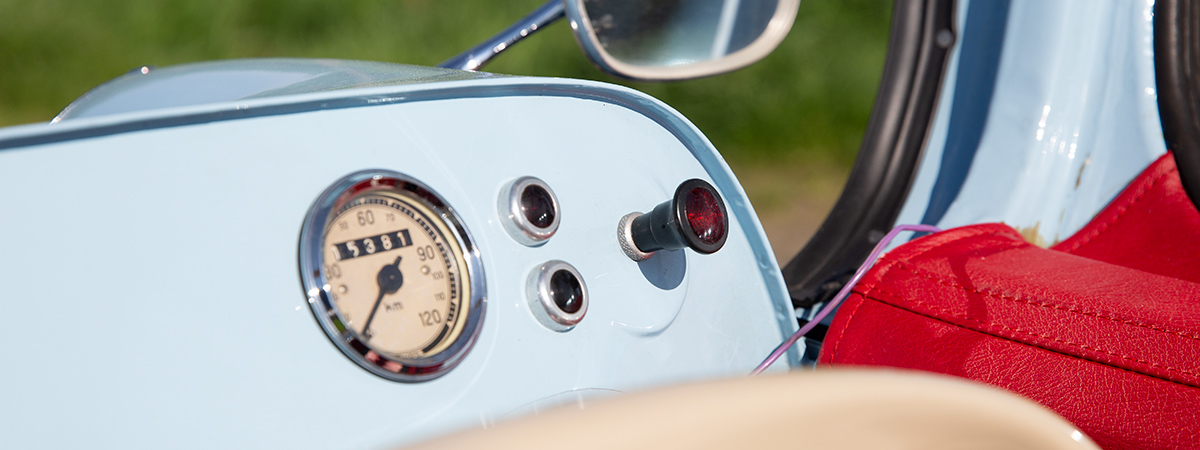Retrofit warning lights: making classic cars safer

Autore: Udo Schneider
Posizione: Vendite
Aggiornato: 17/01/2022

Hazard warning lights: Retrofitting on classic cars is mandatory
Normally, for a classic car, the time when the vehicle was first registered determines what needs to be retrofitted. The regulations valid in the year of the first registration apply to the classic (in its original condition) today, but a few things definitely have to be installed. As a rule, a hazard warning system must be present.
A classic vehicle must remain as close to its original condition as this is the only way it can get the H mark, which attests that it is a "motor vehicle cultural asset". So use components that do not change the look of the classic, i.e. are contemporary.Do I have to retrofit hazard warning lights?
Yes, there are working hazard warning lights in Germany mandatory for all vehicles since 1970. In older vehicles that were imported from countries where this obligation did not exist - such as the USA - hazard warning lights must be retrofitted. The problem often occurs when approving agricultural machinery, because without hazard warning lights you can't get a test badge.
There are also exceptions in the classic sector. The obligation to install can be avoided if retrofitting is actually not feasible. This is the case with vintage cars from the Brass period, some of which have no electrical system. The experts at the responsible testing organization know about this. In order to avoid the obligation, you need a confirmation or an expert opinion, so that the admissions office allows you an exception.Important: According to German legislation, even classic cars from the UK or America must be equipped according to the time of first registration and the hazard warning lights must be included to. As soon as you buy a classic vehicle from the USA, the hazard warning lights are an important issue.
US vehicles sometimes still have no hazard lights. Retrofitting is made more difficult by the fact that in US vehicles the turn signal and brake light pulsate. There are special solutions for more recent US vehicles, please ask our specialist advisors on 02683-9799-0.
When do the hazard warning lights have to be switched on?
To draw the attention of others to your own car or dangers, you switch on the hazard warning lights one. But when does the law require you to turn them on? The following situations require an intact hazard warning system:
- If you endanger others with your own car - for example by potentially rear-ending at the end of a traffic jam - then you must warn others.
- If a car needs to be towed, both the tow tractor and the towed vehicle are required to turn on their hazard warning lights throughout the process.
- If your own car breaks down and is therefore a danger to others, then the hazard warning lights must be activated (and the warning triangle set up).
- Even if the car is moving slowly due to a defect, you must alert others with the hazard warning lights.
Warning lights: installation and connection
Other classics still have a 6-volt electrical system and therefore also need a 6-volt system.
For vehicles with a 12-volt system, whether with positive or negative polarity, the universal hazard warning system from our range of vehicle electronics is suitable. For classics that are already equipped with a turn signal cut-off relay, there are hazard warning flasher systems that are designed for this.
- Vehicles with combined turn signal/brake lights (only one bulb per side) have rear lights controlled by a control relay will. Therefore, the hazard warning lights should be connected directly to the control relay. If necessary, you can lengthen the cables.
- On vehicles with separate turn signal and brake lights (one brake light and one turn signal per side), the hazard warning light channel is best connected to both near the turn signal switch Turn signal circuits connected.
Warning: However, only those who have an idea of the subject should get to work here. Because even the smallest mistake can quickly lead to fire. And you don't want to endanger yourself or your collector's vehicle unnecessarily?
Hazard warning lights: Installation in a classic
Install the hazard warning lights as appropriately as possible and adhere to the technical specifications . The control button of the hazard warning system must be illuminated in red and also flash. It must also be installed in the driver's field of vision.Here are a few options:
- Many vehicles have unused holes, cutouts or switches in the dashboard or around the cockpit. Use existing holes for installation.
- Alternatively, there are small consoles and housings that can be screwed in from below to be mounted on the dashboard. In this way, the hazard warning lights can be installed cleanly and professionally.
- There is often some space in the center console, or the hazard warning lights are hardly installed in place of the current one still used cigarette lighter.
Warning lights: connection to the classic
After installation at a suitable location, the electrical connection is made. Some experience in dealing with automotive electrical systems is helpful. Follow the instructions step by step and be sure to note the different color coding of the electrical system. Also check the passages. Here is a rough overview of the steps:
- Disconnect the car battery or set the main battery switch to "off". Always the ground first.
- First, supply the system with electricity. You need terminal 30 (fused) and ground.
- Then create the connection to the right and left indicator circuit. If, when installing the hazard warning lights, you come across an electrical system that has already been modified and is no longer standard, there is no shame in entrusting the installation to professional hands.
- Clamp it Battery back on and check the indicators and hazard warning lights are working properly.
For many vehicles, there are extended wiring harnesses, in which the non-standard hazard warning lights can be fully wired and installed. If the wiring harness needs to be replaced anyway as part of a restoration, this is a very convenient solution. Ask our specialist advisors.
Retrofitting the hazard warning lights: tools
If you have to retrofit the hazard warning lights on your classic car, you need the suitable tools, manual skills and knowledge of the vehicle electrical system that is installed in your classic car. You can install a hazard warning light system yourself if you have the appropriate background knowledge. We recommend that you follow our detailed instructions.
- Crimping tool for insulated crimp connectors
Conclusion
As the proud owner of a classic car, you certainly don't want to take any action that will cost the vehicle its classic car status. Even if it hardly ever happens today: the installation of hazard warning lights is fortunately a minimal intrusion into the visual authenticity, but a maximum contribution to road safety and roadworthiness of the vehicle. With experience and skill you can install the hazard warning lights yourself and thus fulfill your duty.FAQ
Here you will find answers to frequently asked questions from the community about the hazard warning lights.
Is it compulsory to retrofit the hazard warning lights?
Yes. The hazard warning lights are part of the mandatory retrofits alongside the anti-theft device. In rare exceptional cases, you can commission an expert opinion that exempts you from the obligation if the installation is not technically feasible.
Can I install the hazard warning lights myself?
Yes, you can. The prerequisite is know-how about the electrical system in your classic car, and you also need suitable tools and skills.
How much does it cost on average to retrofit the hazard warning lights?
Not all hazard warning flasher modules cost the same, but on average you can expect material costs of around 100 to 200 euros. If you use the services of a specialist workshop, you must expect higher amounts, depending on the time involved. Installation takes between two and five hours, depending on whether there are any complications, etc.Which retrofits are not mandatory, but make sense?
For vehicles imported for the first time and freshly imported, a large number of conversions are usually required, some of which can be very complex. Before you buy, find out about possible conversion requirements for headlights, glazing, lamps, brake and air conditioning. After these upgrades, which are essential for the technical inspection, we always recommend a look at the next most important point, the safety equipment.
Can I install modern electronics?
Of course you can use electronic components when retrofitting the hazard warning lights. Hide their often unsuitable look in the housing of an old flasher relay so that the look of the classic is not disturbed. Make sure that the electronic relays can handle the currents to be switched and avoid cable cross-sections that are too small. Electronic solutions are often not welcomed by classic car enthusiasts due to the many limitations.